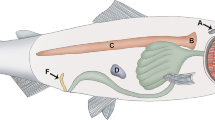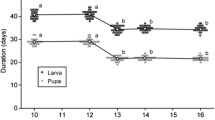Summary
Under certain conditions transplantation and extirpation experiments with the legs ofLeucophaea maderae (Blattaria, Blaberidae) are followed by the development of intercalary regenerates. Such experiments have suggested the existence of segmental gradients. The experiments in this study were done to elucidate the origin of the intercalary regenerate by exchanging parts of the legs between the closely related speciesLeucophaea maderae andGromphadorhina portentosa.
-
1.
Following the extirpation of middle pieces out of a leg segment,Gromphadorhina responds with the development of an intercalary regenerate in the same manner as doesLeucophaea. These results suggest that there are segmental gradients in the legs ofGromphadorhina, too.
-
2.
If one combines the tissues of both species, they react in a coordinated manner. An intercalary regenerate develops only when, by transplantation, gradient discontinuities are established. The coordinated action of the tissues suggests that the gradient factors are the same or at least very similar in both species.
-
3.
Both participants may share in building the intercalary regenerate to a varying extent. Including the results of earlier experiments one may state: The regenerate in most cases is built entirely or to a great extent by that participant which has the most distal amputation level. As a rule, the intercalary regenerate is built up by disto-proximal regeneration, i.e. the regeneration of a proximal segment area occurs from a distal level.
-
4.
The tissues regenerating an intercalary regenerate preserve their characteristic, leg specific state of determination: no change of fore leg tissue to hind leg tissue (or the reverse) has ever been noticed. So, the origin of a regenerate is deducible from its structure.
Similar content being viewed by others
Literatur
Balazuc, J.: La tératologie des Coléoptères et expériences de transplantation surTenebrio molitor L. Mém. Mus. Nat. Hist. Nat., N.S.25, 1–293 (1948).
Bodenstein, D.: Beintransplantationen an Lepidopterenraupen. III. Zur Analyse der Entwicklungspotenzen der Schmetterlingsbeine. Wilhelm Boux' Arch. Entwickl.-Mech. Org.133, 156–192 (1935).
—: Beintransplantationen an Lepidopterenraupen. IV. Zur Analyse experimentell erzeugter Bein-Mehrfachbildungen. Wilhelm Roux' Arch. Entwickl.-Mech. Org.136, 745–785 (1937).
Bohn, H.: Analyse der Regenerationsfähigkeit der Insektenextremität durch Amputations- und Transplantationsversuche an Larven der Afrikanischen SchabeLeucophaea maderae Fabr. (Blattaria). I. Regenerationspotenzen. Wilhelm Roux' Arch. Entwickl.-Mech. Org.156, 49–74 (1965).
—: Interkalare Regeneration und segmentale Gradienten bei den Extremitäten vonLeuco- phaea-Larven (Blattaria). I. Eemur und Tibia. Wilhelm Roux' Archiv165, 303–341 (1970a).
—: Interkalare Regeneration und segmentale Gradienten hei den Extremitäten vonLeuco-phaea-Larven (Blattaria). II. Coxa und Tarsus. Develop. Biol.23, 355–379 (1970b).
Bullière, D.: Sur le déterminisme de la qualité régionale des régénérats d'appendices chez la Blatte,Blabera craniifer. J. Embryol. exp. Morph.23, 323–335 (1970).
—, Sengel, P.: Sur le déterminisme de la différenciation qualitative des cellules au cours de la régénération des appendices thoraciques chezBlabera craniifer (Insecte Dictyoptère). C. R. Acad. Sci. (Paris), Sér. D,270, 1141–1144 (1970a).
— —: Nouvelles données sur la détermination qualitative des cellules au cours de la régénération chez les Insectes. G. B. Acad. Sci. (Paris), Sér. D,270, 2556–2559 (1970b).
Furukawa, H.: Transplantation-experiments onAnisolabis martima (Dermaptera). Annot. Zool. Jap.19, 175–184 (1940).
Hannah, A.: Non-autonomy of yellow in gynandromorphs ofDrosophila melanogaster. J. exp. Zool.123, 523–560 (1953).
Hoarau, F.: La régulation dans les territoires de régénération chez l'Isopode terrestreHelleria brevicornis Ebner. Ann. Embryol. Morphogen.2, 87–103 (1969).
Lecamp, M.: Sur le déterminisme de la courbure coaptative du fémur des membres anterieurs des Phasmes. C. R. Acad. Sci. (Paris)202, 694–696 (1936).
Mauser, F.: Synchrone Metamorphose deplantierter Vorderbeine mit dem WirtstiereDixippus morosus Br. et. Redt. Biol. gen.14, 179–211 (1938).
Sellier, R.: Transplantation et mue induite d'appendices d'adultes chezAcheta campestris L. (Insecte Orthoptère). C. R. Soc. Biol. (Paris)140, 965–966 (1946).
Stern, C.: Two or three bristles. Amer. Sci.42, 213–247 (1954).
—: The genetic control of developmental competence and morphogenetic tissue interactions in genetic moscaics. Wilhelm Roux' Arch. Entwickl.-Mech. Org.149, 1–25 (1956).
—: Genetic mosaics in animals and man. In: Genetic mosaics and other essays, p. 27–129. Cambridge: Harvard Univ. Press 1968a.
—: Developmental genetics of pattern. In: Genetic mosaics and other essays, p. 130–173. Cambridge: Harvard Univ. Press 1968b.
—, Tokunaga, C.: Nonautonomy in differentiation of pattern-determining genes inDrosophila. I. The sex comb of eyeless-dominant. Proc. Nat. Acad. Sci. (Wash.)57, 658–664 (1967).
Stock, A.: Homoeosis und Regenerationsgeschwindigkeit beiDixippus morosus Br. et Redt. sowie anderen Insekten. Anz. Akad. Wiss. Wien, math.-naturw. Kl.74, 198–201 (1937).
Tokunaga, C.: Nonautonomy in differentiation of pattern-determining genes inDrosophila. II. Transplantation of eyeless-dominant leg disks. Develop. Biol.18, 401–413 (1968).
—, Stern, C.: Determination of bristle direction inDrosophila. Develop. Biol.20, 411–425 (1969).
Ursprung, H., Hadorn, E.: Weitere Untersuchungen über Musterbildung in Kombinaten aus teilweise dissoziierten Flügel-Imaginalscheiben vonDrosophila melanogaster. Develop. Biol.4, 40–66 (1962).
Urvoy, J.: Étude anatomo-fonctionelle de la patte et de l'antenne de la BlatteBlabera craniifer Burmeister. Ann. Sci. Nat. Zool., Sér.12, 5, 287–413 (1963a).
—: Transplantation de patte prothoracique en place de patte métathoracique chezBlabera craniifer Burm. Bull. Soc. Zool. Fr.88, 269–273 (1963b).
—: Homogreffe de tarse en place d'antenne chez le PhasmeSipyloidea sipylus Westwood. C. R. Acad. Sci. (Paris), Sér. D,267, 1010–1012 (1968).
Author information
Authors and Affiliations
Rights and permissions
About this article
Cite this article
Bohn, H. Interkalare Regeneration und segmentale Gradienten bei den Extremitäten vonLeucophaea-Larven (Blattaria). W. Roux' Archiv f. Entwicklungsmechanik 167, 209–221 (1971). https://doi.org/10.1007/BF00584250
Received:
Issue Date:
DOI: https://doi.org/10.1007/BF00584250




